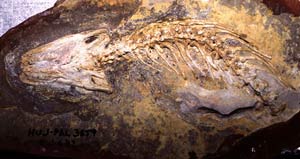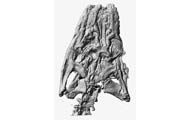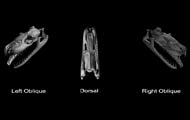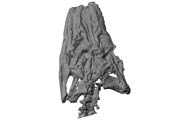Literature
Andrews, R. C. 1921. A remarkable case of external hind limbs in a humpback whale. American Museum Novitates 9:1–6.
Bejder, L., and B. K. Hall. 2002. Limbs in whales and limblessness in other vertebrates: mechanisms of evolutionary and developmental transformation and loss. Evolution & Development 4:445–458.
Caldwell, M. W. 1999. Squamate phylogeny and the relationships of snakes and mosasauroids. Zoological Journal of the Linnean Society 125:115–147.
Caldwell, M. W. 2000. On the phylogenetic relationships of Pachyrhachis within snakes: a response to Zaher (1998). Journal of Vertebrate Paleontology 20:187–190.
Caldwell, M. W., and M. S. Y. Lee. 1997. A snake with legs from the marine Cretaceous of the Middle East. Nature 386:705–709.
Caldwell, M. W., and A. Albino. 2002. Exceptionally preserved skeletons of the Cretaceous snake Dinilysia patagonica Woodward, 1901. Journal of Vertebrate Paleontology 22:861–866.
Cohn, M. J., and C. Tickle. 1999. Developmental basis of limblessness and axial patterning in snakes. Nature 399:474–479.
Cope, E. D. 1869. On the reptilian orders Pythonomorpha and Streptosauria. Proceedings of the Boston Society of Natural History 12:250–266.
Estes, R., T. H. Frazzetta, and E. E. Williams. 1970. Studies on the fossil snake Dinilysia patagonica Woodward. Part I. Cranial morphology. Bulletin of the Museum of Comparative Zoology 140:25–74.
Estes, R., K. de Queiroz, and J. Gauthier. 1988. Phylogenetic relationships within Squamata. In Estes, R. and Pregill, G. (eds), Phylogenetic Relationships of the Lizard Families: Essays commemorating Charles L. Camp. Stanford University Press: Stanford, California, pp. 119-270.
Haas, G. 1979. On a new snakelike reptile from the Lower Cenomanian of Ein Jabrud, near Jerusalem. Bulletin du Muséum national d’Histoire naturelle, Paris (Series 4) 1:51–64.
Haas, G. 1980a. Pachyrhachis problematicus Haas, snakelike reptile from the Lower Cenomanian: ventral view of the skull. Bulletin du Muséum national d’Histoire naturelle, Paris (Series 4) 2:87–104.
Haas, G. 1980b. Remarks on a new ophiomorph reptile from the lower Cenomanian of Ein Jabrud, Israel, p. 177–192. In Jacobs, L.L. (ed.), Aspects of Vertebrate History, Museum of Northern Arizona Press, Flagstaff, Arizona.
Lee, M. S. Y. 1997a. On snake-like dentition in mosasaurian lizards. Journal of Natural History 31: 303-314.
Lee, M. S. Y. 1997b. The phylogeny of varanoid lizards and the affinities of snakes. Philosophical Transactions of the Royal Society of London B 352:53-91.
Lee, M. S. Y., and M. W. Caldwell. 1998. Anatomy and relationships of Pachyrhachis problematicus, a primitive snake with hindlimbs. Philosophical Transactions of the Royal Society of London B 352:1521–1552.
Lee, M. S. Y., J. D. Scanlon. 2002a. The Cretaceous marine squamate Mesoleptos and the origin of snakes. Bulletin of the Museum of Natural History, London 68(2):131–142.
Lee, M. S. Y., and J. D. Scanlon. 2002b. Snake phylogeny based on osteology, soft anatomy and ecology. Biological Reviews 77:333–401.
Newtek Inc. 2004. Lightwave 3D. Newtek Incorporated. San Antonio, Texas.
Rage, J. C., and F. Escuillie´. 2000. Un nouveau serpent bipède du Cénomanien (Crétacé). Implications phylétiques. Comptes Rendus de l’Académie des Sciences de Paris, Sciences de la Terre et des Planètes 330:513–520.
Rasband, W. 2003. ImageJ version 1.31. National Institutes of Health. Bethesda, Maryland, USA.
Rieppel, O., and M. Kearney. 2001. The origin of snakes: limits of a scientific debate. Biologist 48:100–114.
Rieppel, O. 1979. A cladistic classification of primitive snakes based on skull structure. Z. Zool. Syst. Evolutionsforsch. 17:140-150.
Rieppel, O., and H. Zaher. 2000a. The intramandibular joint in squamates, and the phylogenetic relationships of the fossil snake Pachyrhachis problematicus Haas. Fieldiana, Geology 43:1–69.
Rieppel, O., and H. Zaher. 2000b. The braincases of mosasaurs and Varanus, and the relationships of snakes. Zoological Journal of the Linnean Society 129:489–514.
Rieppel, O., H. Zaher, E. Tchernov, and M. J. Polcyn. 2003. The anatomy and relationships of Haasiophis terrasanctus, a fossil snake with well-developed hind limbs from the mid-Cretaceous of the Middle East. Journal of Paleontology 77(3):536–558.
Tchernov, E., O. Rieppel, H. Zaher, M. J. Polcyn, and L. L. Jacobs. 2000. A fossil snake with limbs. Science 287:2010–2012.
Underwood, G. 1967. A contribution to the classification of snakes. British Museum (Natural History) 653:1–179.
VayTek, 2000. Voxblast 3.0. Image Analysis Facility. University of Iowa, Ames, Iowa, USA.
Whiting, M.F., S. Bradler, and T. Maxwell. 2003. Loss and recovery of wings in stick insects. Nature 421:264–267.
Wiens, J.J., and J. L. Slingluff. 2001. How lizards turn into snakes: A phylogenetic analysis of body-form evolution in anguid lizards. Evolution 55(11):2303–2318.
Zaher, H. 1998. The phylogenetic position of Pachyrhachis within snakes (Squamata, Lepidosauria). Journal of Vertebrate Paleontology 18:1–3.
Zaher, H., and O. Rieppel. 1999a. Tooth implantation and replacement in squamates, with special reference to mosasaur lizards and snakes. American Museum Novitates 3271:1-19.




 ,
, 








